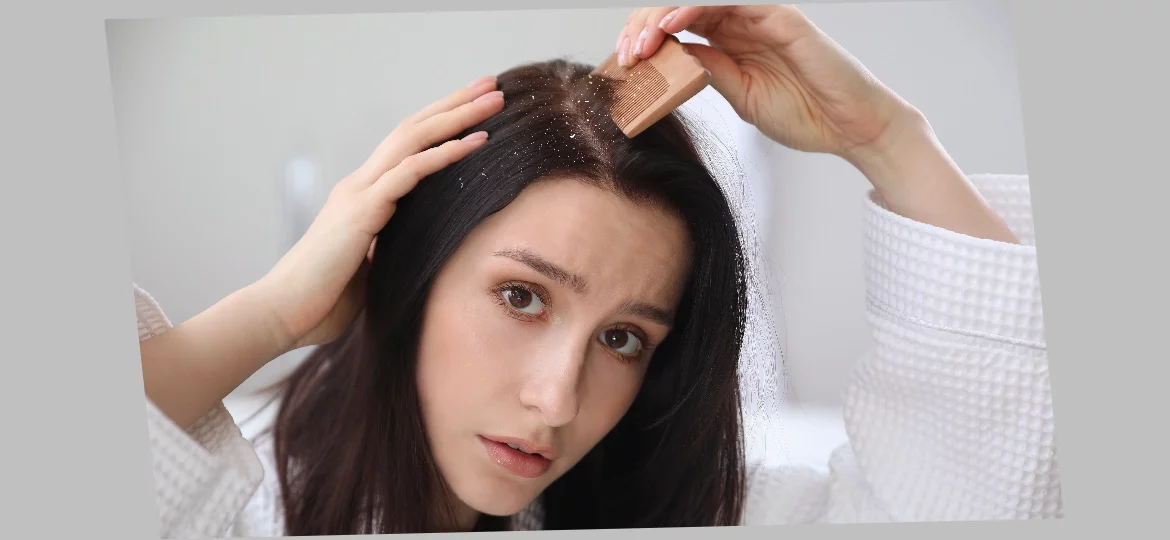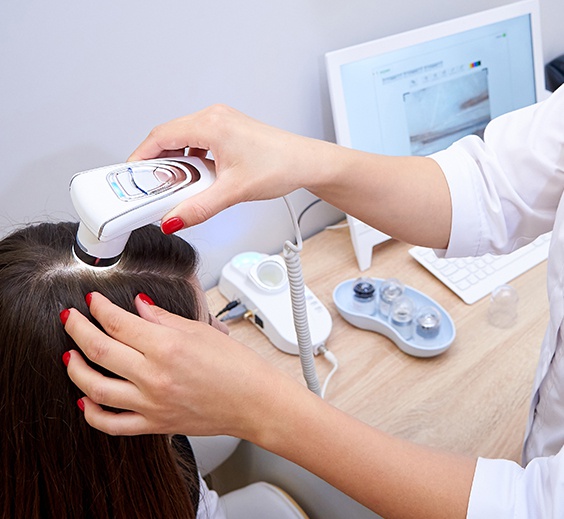
How to Get Rid of Dandruff and Restore Scalp Health
Itching, white flakes on your shoulders, “snow” on your brush—sound familiar? Dandruff doesn’t simply disappear on its own, and switching shampoos only offers temporary relief.
Let’s break down what’s really happening on the scalp, how to care for it properly at home, and when professional diagnostics can save you months of frustration.
Dandruff Explained in 30 Seconds
- 8 out of 10 cases of dandruff are tied to microbiome imbalance and the activity of Malassezia yeast.
- A 2–4 week course with active shampoos can resolve mild cases at home.
- Don’t mistake dandruff for psoriasis or seborrheic dermatitis—the treatment approach is very different.
- Scalp peels (when chosen correctly and guided by diagnostics) can speed results 2–3×.
- Laser photobiostimulation offers a gentle way to support remission and keep follicles healthy.
- Red flags—such as plaques, crusting, or excessive shedding—are signs you should see a dermatologist right away.
At Solea Beauty Salon we perform trichology & scalp diagnostic (trichoscopy + correction plan), professional peels, and laser support protocols.
What is Dandruff?
Dandruff isn’t just dryness. Most often it’s the skin’s reaction to a microbiome imbalance and an overgrowth of Malassezia yeasts. Stress, hormonal fluctuations, seasonal shifts, and heavy styling products can “switch on” relapses. That’s why regular shampoos remove flakes but don’t address the cause.
When dandruff tends to come back more often:
- Fall/Spring—immune load and temperature swings.
- Chronic stress, lack of sleep.
- Oily scalp, infrequent washing, heavy products at the roots.
- Harsh surfactants in care products, hard water.
Don’t Mix Them Up: Dandruff vs. Seborrheic Dermatitis vs. Psoriasis
Dandruff
- Scales: White/yellowish, loose.
- Itching: Mild to moderate.
- Location: Mainly the scalp.
- Surrounding skin: Not painful.
Seborrheic dermatitis
- Scales: Yellowish, greasy, often with redness.
- Itching: Often noticeable, may burn.
- Location: Sides of the nose, eyebrows, ears + scalp.
- Surrounding skin: Redness, inflammatory patches.
Psoriasis
- Scales: Dense, silvery plaques.
- Itching: Can be painful.
- Location: Scalp + frontal hairline, ears, elbows.
- Surrounding skin: Erythema, tenderness.
If you’re unsure, trichoscopy helps quickly determine the scalp condition. It saves months of guesswork and lets you choose individualized care.
Home Care for 30 Days
You can start with a 2–4 week home course using active shampoos and products to see how your skin responds.
Apply them only to the scalp, not the hair. Leave the product on for 5–10 minutes to let the active ingredient work. A light scalp massage during the wait enhances the effect and helps lift flakes (it’s better to use your fingers than a brush—less irritation). Then rinse with warm water. Use 2–3 times per week; on other days, opt for gentle cleansing without active ingredients.
When will you start to see results?
Within 7–10 days you’ll usually feel less itching and flaking. Full effect comes when you follow the 30-day plan.
Important
A home course helps with mild dandruff, reducing itch and flaking. Nevertheless, it doesn’t always reveal hidden inflammatory foci, which are present in up to 70% of dandruff cases.
At Solea Beauty Salon, we perform a scalp diagnostic and develop a personalized care plan. This helps identify the problem and fine-tune a precise regimen for your skin type/coloring.
Anti-Dandruff Actives: A Cheat Sheet with Nuances
- Ketoconazole 1–2% — reduces fungus, calms inflammation, prevents relapses.
- Selenium sulfide 1% — effective for moderate forms; may slightly lighten very light hair.
- Piroctone olamine / Climbazole — gentler for sensitive skin, an alternative to classic formulas.
- Salicylic acid 1.8–3% — lifts scales and improves penetration of other actives.
- Ciclopirox — an RX option if dandruff resists standard treatment (use as prescribed by a physician).
For effective results, combine: a ketoconazole course → maintenance with salicylic acid once a week.
Do not layer multiple active ingredients in one go—it increases the risk of irritation.
Active shampoos lift flakes gradually—but what if you don’t want a long, tedious battle with dandruff? How can you speed things up?
Want Faster Results? A Scalp Peel Could Be the Answer
Scalp peels are procedures that are based on salicylic, glycolic, or lactic acids. They gently remove excess scales and sebum, smooth the scalp, and help restore balance. After a professional peel, home shampoos and lotions work deeper and faster.
Important to consider!
With very sensitive or atopic skin, gentle options or a small test area may be recommended before a full procedure.
At Solea Beauty Salon, we offer professional scalp peeling procedures based on salicylic or combination acids. We build them into an anti-dandruff course only after diagnostics, to amplify therapy without risking your skin’s health.
Magnified Diagnostics: Why Trichoscopy Matters
Trichoscopy is an examination of the hair and scalp under magnification using a special device. With trichoscopy you can:
- Distinguish dandruff from psoriasis and seborrheic dermatitis. They may look similar to ordinary dandruff but require different care methods.
- Assess the condition of skin and hair. You can see whether inflammation is present, how dense and sturdy the hairs are, and their diameter. This is crucial for choosing suitable products and procedures.
- Create a personalized care plan. Instead of trying various shampoos and procedures blindly, you get specific recommendations for your skin and hair type. This saves months of experiments and lowers the risk of inappropriate care.
At Solea Beauty Salon, the trichology & scalp diagnostic service includes trichoscopy and an individualized correction plan for your scalp and hair.


Laser Support: Gentle Yet Deep
Laser photobiostimulation is a gentle, safe technology that improves scalp blood flow and stimulates hair follicles. It doesn’t damage the skin, doesn’t cause burns, and acts deeper than standard massage or topical care.
It’s especially effective with a non-ablative Er:YAG laser. This modern, highly precise laser penetrates into deeper skin layers without destroying the surface. In practice, it means your hair gets nourishment and growth stimulation without skin trauma.
Why this matters:
Even if dandruff looks defeated externally, hidden inflammatory foci often remain on the scalp. Laser support helps target these deeper zones—improving penetration of active shampoo components and strengthening hair from within.
At Solea Beauty Salon, we use specially developed protocols on the Fotona platform for scalp care. These are considered laser settings—precise intensity, duration, and session frequency—so the procedure works as effectively as possible. Protocols are prescribed after an exam and perfectly complement baseline therapy.
Relapse Triggers
Dandruff tends to return, and it’s important to understand what provokes it:
- stress and fatigue,
- seasonal fluctuations,
- infrequent washing or greasy styling products,
- harsh shampoos,
- oily scalp / unbalanced diet.
Here’s how to avoid a comeback of dandruff
Gentle shampoos
Choose products without harsh surfactants and additives (look for “sulfate-free,” “for sensitive scalp”). Fragrance-free and dye-free is the best choice between active courses.
Washing frequency
Adjust to your skin type. Dandruff most often appears with an oily scalp. Ideally, use an active shampoo 2–3× weekly, and on other days—gentle cleansing.
Maintenance care
Use a shampoo or lotion with an antifungal component once a week to prevent relapse.
Seasonal changes
In winter and fall, use gentler shampoos and add hydrating scalp care (fragrance-free lotions, thermal water sprays). In spring and summer, keep the scalp clean since sebum production is more active.
Nutrition
Balance your diet. Zinc, B vitamins, omega-3s, and adequate protein help skin repair. For example, add nuts, fish, eggs, and legumes. Limit sweets, greasy foods, and fast food to avoid triggering excess sebum.
Stress
Reduce stress and ensure quality sleep. It supports immunity and lowers the chance of dandruff relapse.
Styling products
Don’t apply them to the roots to avoid provoking oiliness and scalp irritation.
30-Day Maintenance Plan
Weeks 1–2
Active shampoo 3× per week. Use specialty products with antifungal or soothing components (e.g., piroctone olamine, panthenol). Apply only to problem scalp areas where you feel itching or see flaking. They help reduce inflammation and calm the skin without overloading the hair.
Weeks 3–4
Reduce active shampoo use to 1–2× per week, add hydrating care (gentle serums, emulsions, or masks).
Maintenance
Use an active shampoo once a week; at the first signs of return—go back to the intensive schedule.
Red Flags: When To See A Doctor Immediately
Attention!
Home remedies are effective only for mild or moderate dandruff; in the situations above, self-treatment is risky or ineffective.
FAQ
Dry skin can flake, but that’s not dandruff—it’s simply dryness. True dandruff is almost always related to fungal activity on a more oily scalp.
Detox scrubs help lift scales and clean the surface, but they don’t treat dandruff. To eliminate fungus and inflammation, you need active ingredients that control Malassezia and reduce inflammation.
Sometimes dandruff occurs even with regular washing and proper shampoos because hidden inflammatory foci remain on the skin, which regular products don’t “see” or adequately address.
No More Trial and Error—Get the Right Diagnostics and the Right Care
At Solea Beauty Salon (Sunny Isles Beach, Miami) we:
- perform scalp diagnostic & trichoscopy;
- build a personalized plan for your skin type/coloring;
- add professional peels and Fotona laser photobiostimulation.

